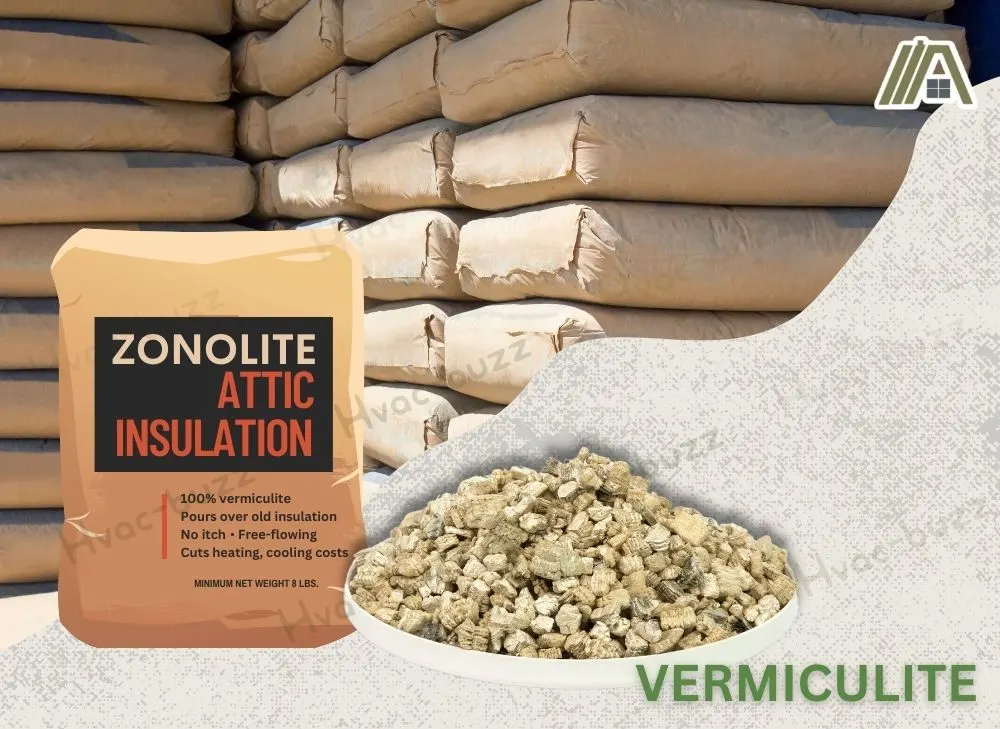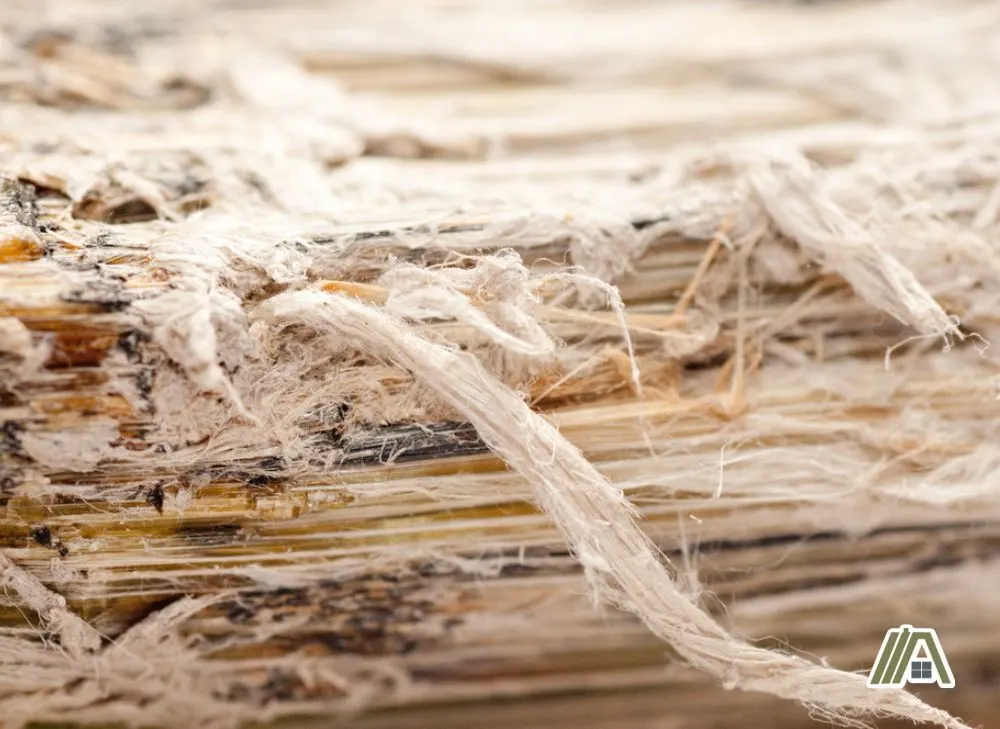Vermiculite insulation is not in nice batts that you can pull out in large chunks. It’s more of a loose-fill insulation that would require a specialist vacuum or a lot of scooping and shoveling to remove.
It is common practice to lay new insulation over old, but vermiculite has a special consideration on top of the typical factors when it comes to upgrading your home insulation.

If vermiculite insulation may be contaminated with asbestos, it is best to leave it alone and not disturb it. This means laying new insulation over old, but this must be done correctly and safely. Getting a professional asbestos abatement company to assess the situation is best if new insulation is needed.
General Rule Is to Leave Vermiculite Alone
Vermiculite is a naturally occurring mineral that was commonly used as insulation in homes and buildings from the 1940s to the 1990s. Most vermiculite used in North America came from one particular mine in Libby, Montana, which was owned by a company called Zonolite.

Unfortunately, the mine, which supplied 70-80% of America’s and Canada’s vermiculite, was contaminated with asbestos. That means most of the vermiculite insulation installed across America and Canada between 1940 and 1984 was also contaminated with asbestos.
Asbestos fibers can become airborne when the vermiculite is disturbed, such as during the process of removing it. If these fibers are inhaled, they can become lodged in the lungs and cause several health problems, including lung cancer, mesothelioma, and asbestosis.
The best approach is to assume that your vermiculite insulation may contain asbestos, and it is widely advised to avoid disturbing it as much as possible. This means if new insulation is needed, it is recommended to lay it over the vermiculite rather than removing the old insulation.
This will help to contain any potential asbestos fibers and reduce the risk of exposure.
Exception
If vermiculite insulation becomes wet or damp, it can provide a favorable environment for mold growth. This is concerning because mold can cause health issues, like allergic reactions, respiratory issues, and other health problems.
Mold is a more immediate (but not necessarily a more serious) concern than asbestos when it comes to vermiculite insulation because it can cause health problems that are more readily apparent and can manifest more quickly than the long-term health effects of asbestos exposure.
Mold can cause respiratory problems, allergies, headaches, and other health issues that can develop within a short period of time.
On the other hand, asbestos-related health problems can take years or even decades to develop after exposure, which is one of the reasons why it took so long to figure out how problematic this miracle material is.
If you need to remove the vermiculite insulation in your home, it is important to understand that this is not a DIY job.
Due to the risk of asbestos exposure, the process of removing vermiculite insulation must be handled by a professional asbestos abatement contractor who is trained and equipped to do the work safely.
The process of removing vermiculite insulation involves specialized procedures and equipment to minimize the release of asbestos fibers into the air.
There are also local, state, and federal regulations for the disposal of asbestos-containing materials.
Potential Problems With Covering Vermiculite
If you are considering covering your vermiculite insulation, you should be aware of some consequences.
Vermiculite insulation may need to be removed if it is falling through gaps and cracks in the ceiling, which can allow it to enter the living spaces of the home.
This increases the risk of exposure to asbestos fibers and may require the removal of the insulation to prevent further contamination.
If you are considering selling your house in the next few years, be aware that some homebuyers may be hesitant to purchase a home with vermiculite insulation due to concerns about asbestos.
In this case, the removal of the insulation may be necessary to facilitate the sale of your property.
If vermiculite insulation needs to be removed, it is important to understand that any new insulation that was installed over it may have become contaminated with asbestos fibers during the removal process.
Asbestos fibers can become airborne when vermiculite is disturbed and can settle on surfaces, including the new insulation. Even if the new insulation appears to be clean, there may still be asbestos fibers present that are not visible to the naked eye.

For this reason, it is typically recommended that new insulation that has been installed over vermiculite insulation be removed and replaced as well.
This can be a time-consuming and costly process, but it is necessary to ensure that the home is free from asbestos contamination.
It is important to note that vermiculite insulation does not necessarily pose an immediate health risk if left undisturbed, and removal should only be considered when necessary.
The process of removing vermiculite insulation involves specialized procedures and equipment to minimize the release of asbestos fibers into the air.
Take Care When Installing New Insulation
If you plan to install new insulation over vermiculite, it is important to avoid disturbing the vermiculite and potentially releasing asbestos fibers into the air.
One recommendation is to lightly mist the surface of the vermiculite with water to prevent dust from becoming airborne when you lay the new insulation. This can help to keep the vermiculite stable and prevent the release of asbestos fibers into the air.
However, it is important to avoid using too much water, as this can create a damp environment that can promote the growth of mold and other fungi.
In addition to misting the vermiculite, it is important to first seal any gaps and cracks to prevent the vermiculite from falling through and getting into the rest of the house. This can help to minimize the risk of exposure to asbestos fibers and prevent contamination of other areas of the home.
It is generally recommended to have any work that involves vermiculite done by a professional who is trained and equipped to handle asbestos safely. This ensures the lowest risk of exposure to asbestos fibers and prevents contamination of other areas of your home.
If you do decide to tackle the job yourself, it is important to wear appropriate personal protective equipment (amazon link) (PPE), such as a respirator, gloves, and protective clothing, to minimize the risk of exposure to asbestos.
It is also not recommended to use any blown-in insulation, such as cellulose or fiberglass, as this can disturb any potential asbestos fibers and cause them to become airborne.
Always Confirm With Your Local Government
It’s important to confirm with your local government about covering up vermiculite because regulations regarding vermiculite insulation can vary by region and may change over time.
In British Columbia, Canada, for example, if vermiculite insulation is suspected of containing asbestos, it must be tested and, if found to contain asbestos, must be removed.
The Wisconsin Department of Health Services requires anyone disturbing or removing vermiculite insulation to notify them before starting any work.
Sources
https://www.health.state.mn.us/communities/environment/asbestos/homeowner/insulation.html
https://www.racinehomeinsulators.com/2017/vermiculite-attic-insulation-frequently-asked-questions
https://www.epa.gov/asbestos/protect-your-family-asbestos-contaminated-vermiculite-insulation
https://www.nytimes.com/2008/08/14/garden/14fix.html
https://mapleleafmold.ca/the-dangers-of-vermiculite-insulation/

